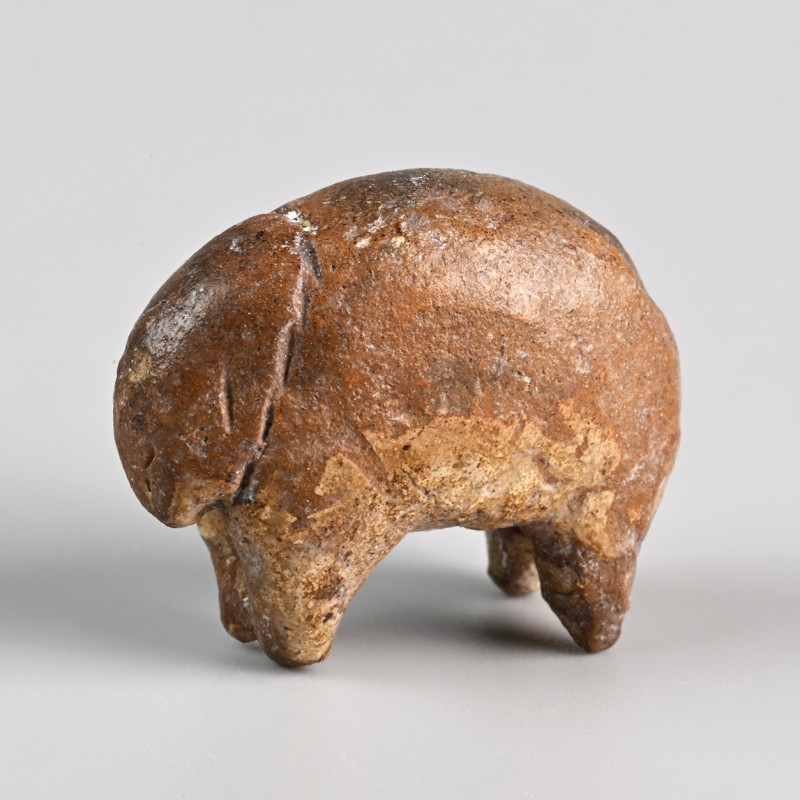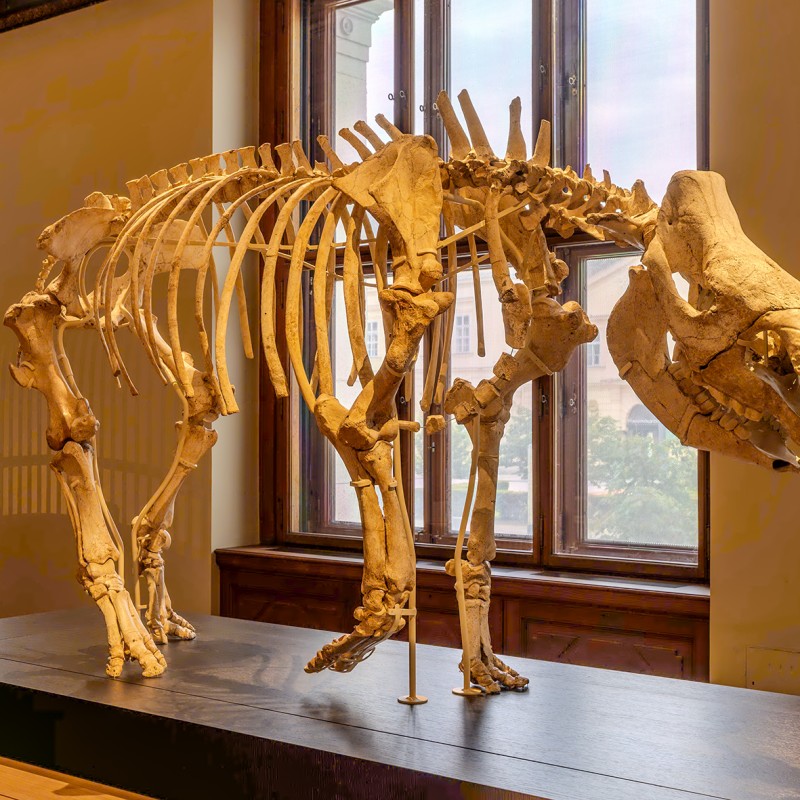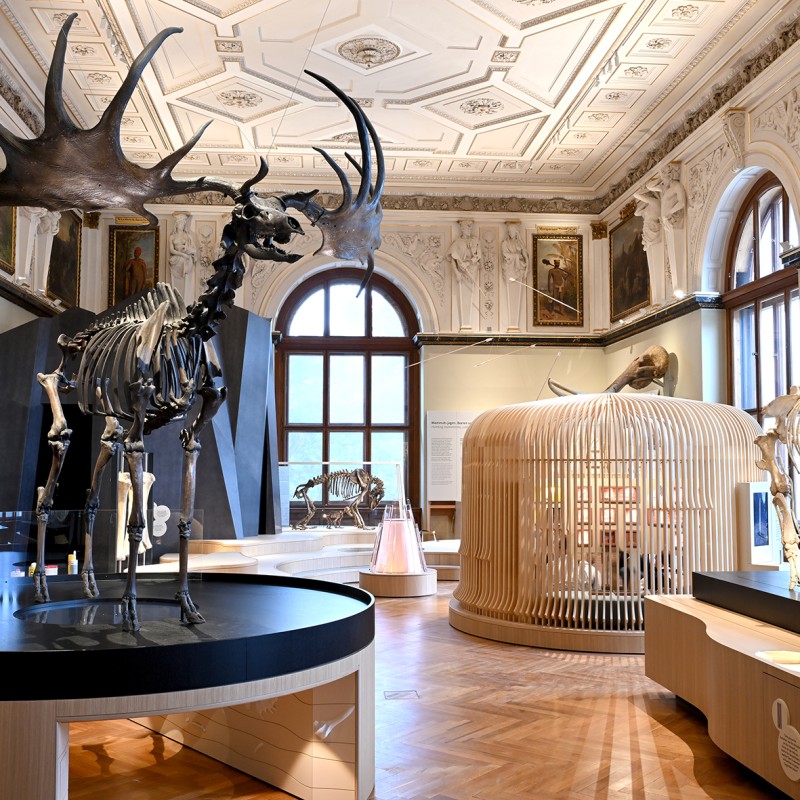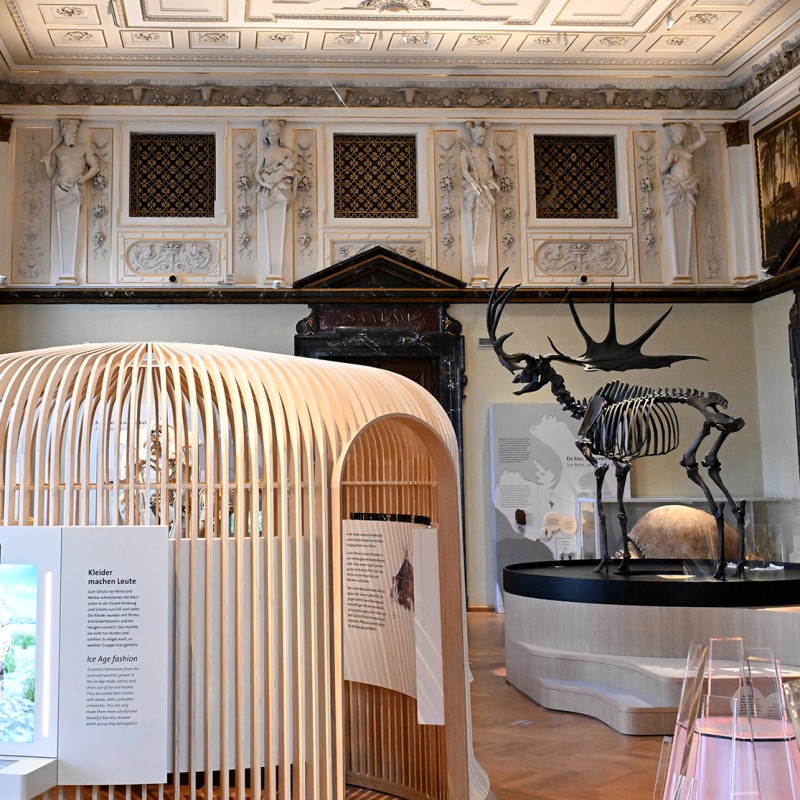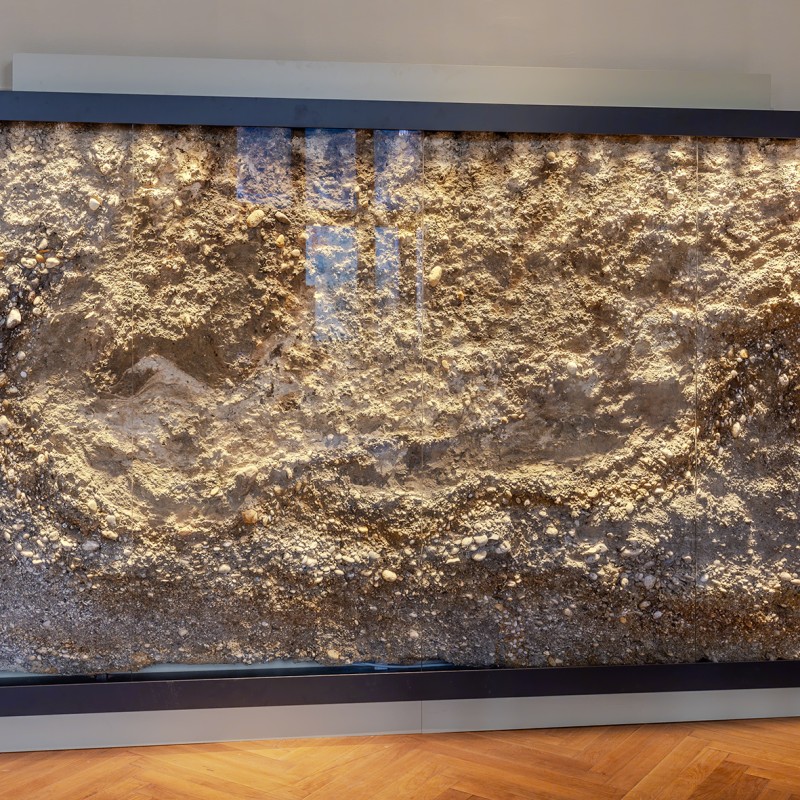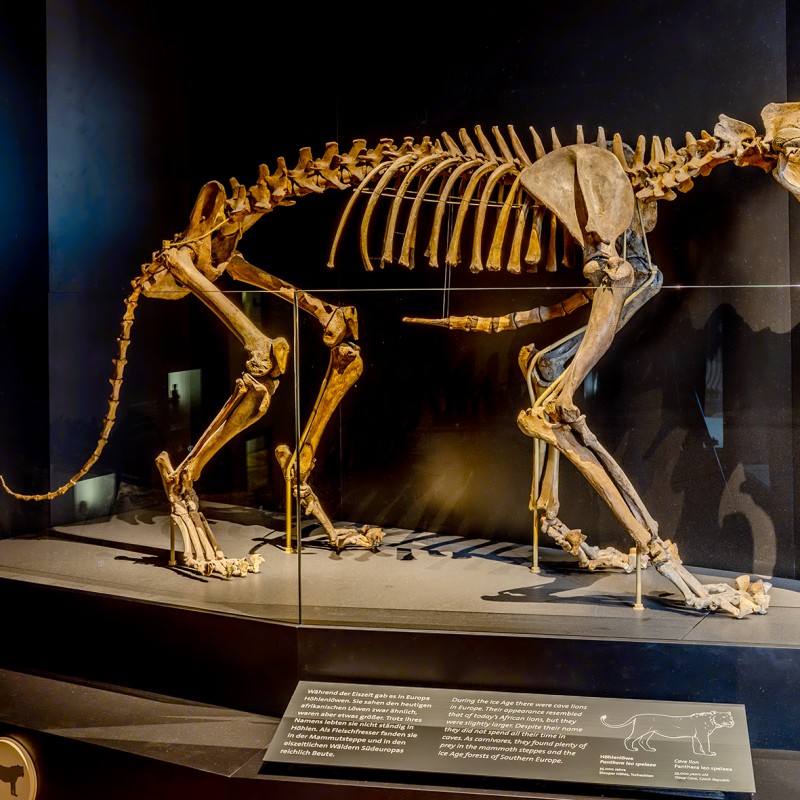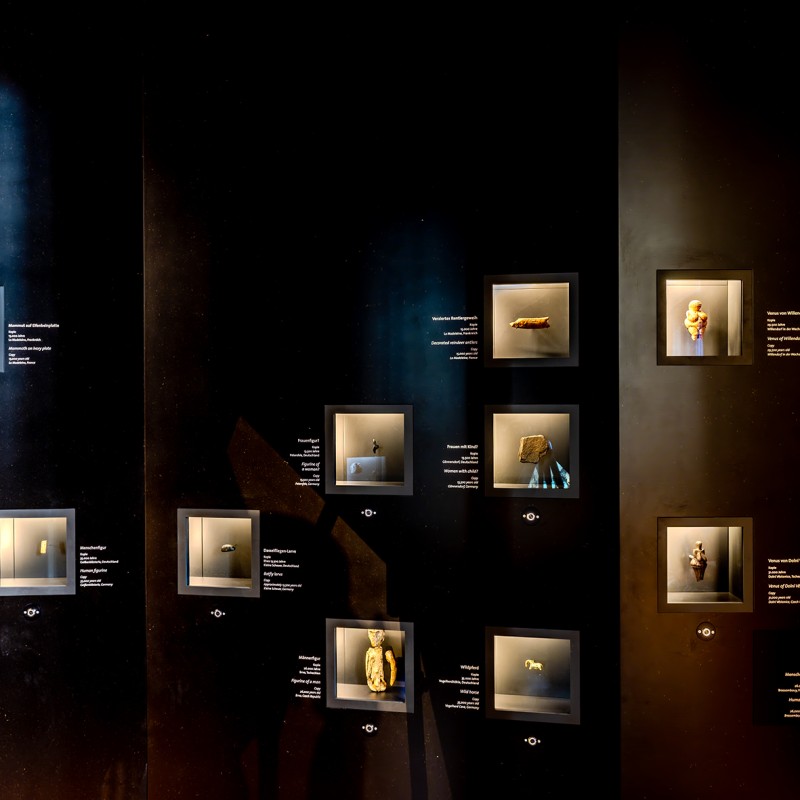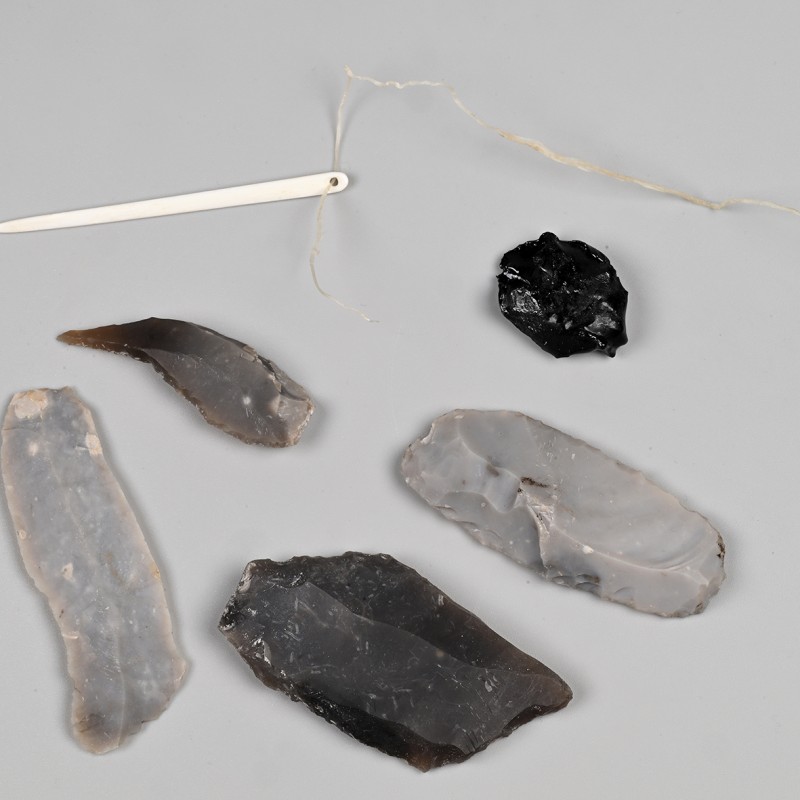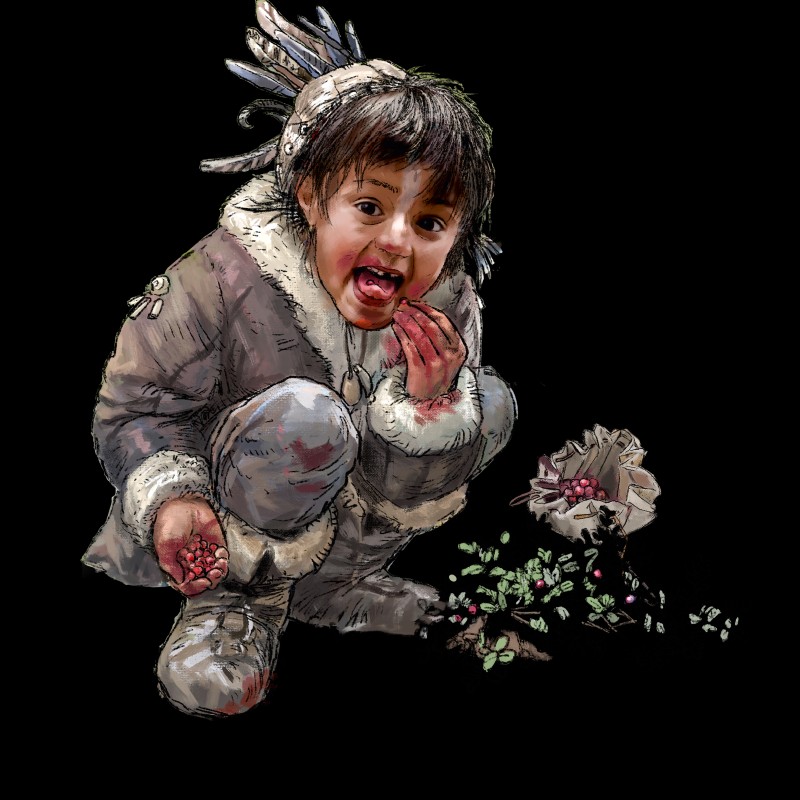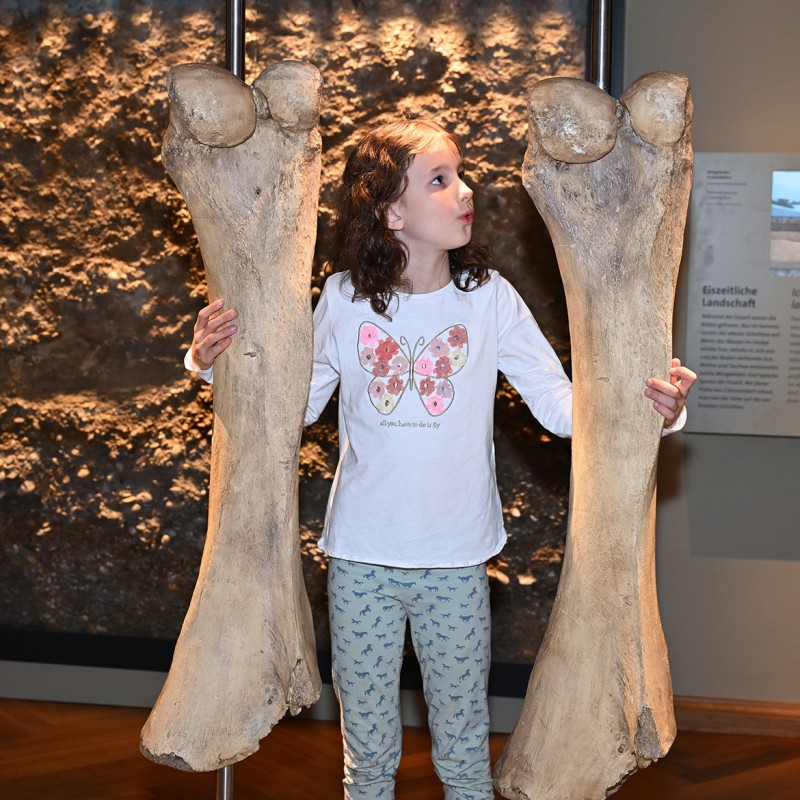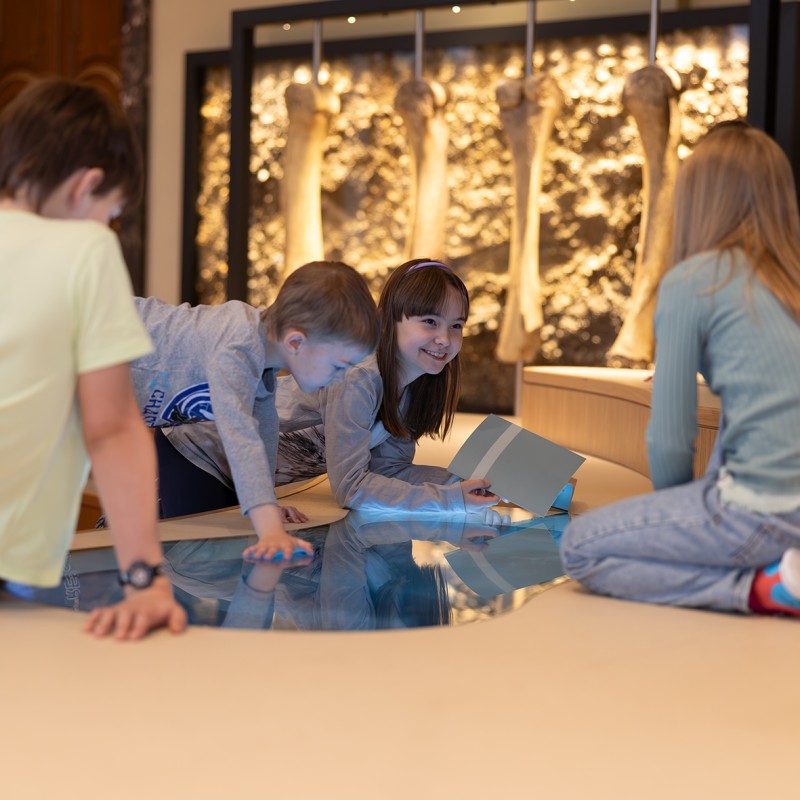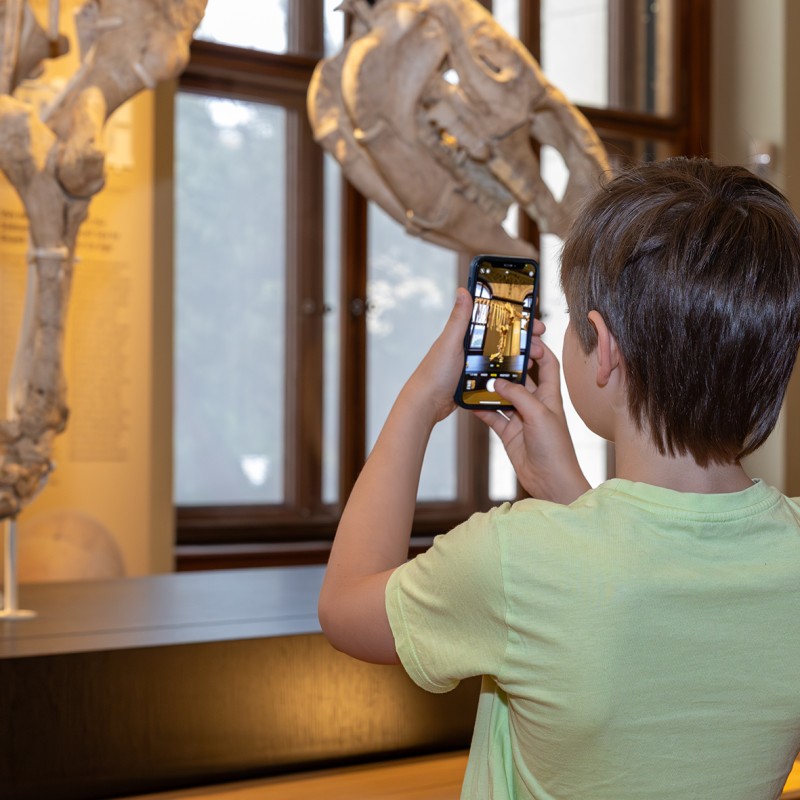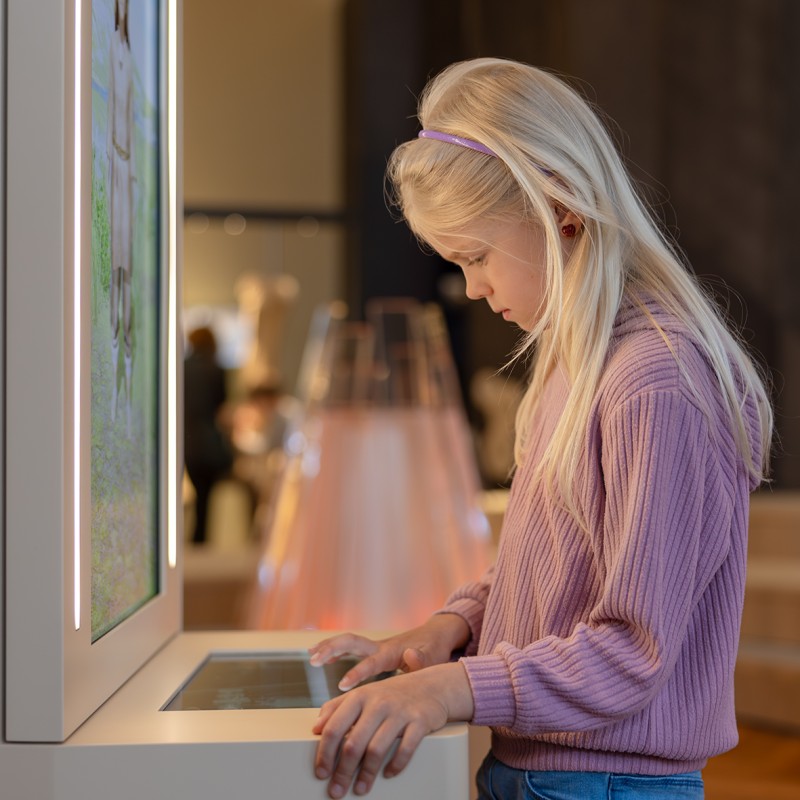Press conference for the opening of the new Kindereizeitsaal "Ice Age Children and their World"
20. May 2025
on Tuesday, 20 May 2025, at 10.30 a.m. in the lecture hall of the NHM Vienna
with a visit to the new Children's Ice Age Room (Room 16 on the 1st floor)
Entry: from 10 a.m. via the main entrance of the NHM Vienna, Maria-Theresien-Platz
Entry: from 10 a.m. via the main entrance of the NHM Vienna, Maria-Theresien-Platz
On the podium in the lecture hall are:
Ice Age children and their world
The Ice Age fascinates: It awakens thoughts of iconic ice age animals such as mammoths, giant deer or cave bears. But also on man-made objects such as the cave paintings in Spain and France or the Venus of Willendorf.
The Ice Age is often described as a world of adults. Ice age children are often neglected.
The exhibition ‘Ice Age Children and their World’ reverses the perspective and combines the theme of the Ice Age with the children’s experience. The concept of the exhibition was developed in cooperation between the departments of prehistory, geology, science communication and exhibition management of the NHM Vienna. In addition, the ideas of three school classes were included in the planning, which were discussed in advance in several workshops together with the curators and implemented as far as possible. The architectural office Schuberth and Schuberth was commissioned with the design execution.
The Ice Age Hall is designed as a place for all generations, where what can be experienced and experienced invite you to engage with the topic in a playful way.
For this purpose, the hall was transformed into an ice-age landscape: When entering, large free-standing skeletons of glacial animals attract attention. A network of paths connects different theme stations and invites you to stroll around; Seating steps and a fireplace in the centre of the hall invite you to linger.
In stations such as ‘At home on the road’, a stylised tent deals with topics such as housing, clothing, play, hygiene and health. Other stations are dedicated to collecting, hunting and nutrition. It becomes clear that animals not only served as food, but were also a resource for tools, jewelry, and clothing. An ice age cave invites you to explore and holds some surprises.
“The new Ice Age Hall offers not only young visitors but also adults an unusual and vivid opportunity to immerse themselves in the world of the Ice Age. The people of the Ice Age are strangers to us – in the end, we don’t know what they laughed or were annoyed about, whether girls and boys could play together or formed separate groups. Here in the museum there is now the opportunity to think and feel in the life world of the Ice Age children. An exercise for life. It is always good to try to think about the living environment of people who grow up and live under different conditions or in completely different cultural circles", emphasises Director-General and Scientific Director Dr. Katrin Vohland, the intention of this new, very special hall.
Ice Age children and their world: The new family exhibition at NHM Vienna
By Caroline Posch, Mathias Harzhauser, Julia Landsiedl and Agnes Mair
Hall 16 of the Natural History Museum has served a number of purposes in its history: From an ethnographic showroom to pile-building huts, a digital planetarium to a lecture hall. After extensive renovation work, you can now explore the living world of Ice Age children 30,000 years ago.
Everyone knows the term ‘ice age’. Animals such as mammoths and saber-toothed cats immediately come to mind. The wonderful cave paintings in France and Spain and the Venus of Willendorf are examples of Ice Age art.
Few people are aware that we are still living in the Ice Age today. For 2.6 million years, the change between cold and warm periods of the ice age climate has dominated our planet. This has had a significant impact on human development.
But what exactly is this: Ice age? – What animals were encountered around Vienna at the time? What plants grew here? And what did the everyday life of the Ice Age people look like?
We learn all this in room 16 of the Natural History Museum. After a total of two years of planning and refurbishment work, he opens his doors to visitors again. They gain an insight into the Ice Age environment, not – as is so often the case – from the eyes of adults, but from the perspective of children.
For a long time, the realities of life of Ice Age children were largely ignored in research as well as in museums. Their contribution to the society and material culture of the Pleistocene was considered too insignificant. However, recent research suggests that children played an extremely important role in Ice Age social life. They sparked innovation, they were artistically active and helped with hunting and collecting. In the exhibition, today's children now have the opportunity to compare their everyday life with that of the Ice Age children, to immerse themselves in the Ice Age world and to ‘understand’ it in the truest sense of the word. The hall has been transformed into an glacial landscape.
With the Ice Age Hall, the aim was to create a place for all generations in which they can playfully acquire tangible and experiential knowledge. As soon as they enter, large free-standing skeletons of the Ice Age animal world attract attention. The room texts are short and invite you to join in and try out. At ten audio stations, a child from the Ice Age talks about his life – from hunting and playing to visiting the toilet. There is the possibility of lighting a digital fire and slipping into ice age clothes. A network of paths connects the theme stations. Sitting steps around a fireplace in the center of the hall invite you to linger.
In stations such as ‘At home on the road’, a stylised tent deals with topics such as housing, clothing, play, hygiene and health. Other stations are dedicated to gathering, hunting, and nutrition, showing that animals not only served as food, but were also a resource for tools, jewelry, and clothing. An ice age cave invites you to explore and holds some surprises. Numerous originals and copies from the Stone Age collection of the NHM Vienna enrich the stations, including objects such as jewelry made of animal teeth, bone beads and fossil snail shells, tools and spear tips made of stone and bone. These give an insight into the jewellery and tool boxes 30,000 years ago, thus offering a view of the everyday culture of the Ice Age people.
The oldest ceramic objects come from children
One of the archaeological highlights is the clay mammoth less than two centimetres in size from the Pavlov site in the Czech Republic. The mammoth was found in 1923. Later it turned out that the figure is almost 30,000 years old. The area between Pavlov and Dolní Věstonice is known for its rich treasures of Ice Age figures. The sensation: The objects were formed from clay and later burned in the fire. These are the oldest ceramic objects in the world. Until recently, the production of figurines of this type was almost exclusively attributed to adults. However, recent research suggests that some of the figures were made by children.
Animal children can also be found in the newly designed hall. A ‘cave bear family’ is waiting in front of the Ice Age cave. In addition to a full-grown cave bear, the skeletons of two young animals are presented. In the larger of the two, even the milk teeth are recognizable. With the change of teeth, therefore, also cave bear children had to fight around.
Original skeletons of giant deer, saber-toothed cat and the strange South American glyptodon, a giant armadillo, are further highlights of the exhibition. The paleontological star is the Hundsheim rhinoceros – a unique object of a warm-time rhinoceros from Lower Austria, which died 700,000 years ago by falling into a karst crevasse.
Caves were not only mystical places, but also playgrounds for children running through the damp cave mud. Visitors learn this in a station where the skeleton of a cave lion is waiting. Like thousands of years ago, you can leave your handprints in the semi-dark!
What is it like to live in the Ice Age as a child?
If you fancy a search for traces, you can choose from a colourful range of programs for children, families or adults at the NHM Vienna, which not only leads into the new Eiszeitkindersaal, but also behind the scenes of the museum.
Families can immerse themselves in the world of Ice Age children during guided tours in Hall 16 in May and June. On Deck 50, cave paintings inspire painting with natural colors. The images of the visitors grow together on our digital cave wall into a common work of art. If you want to try yourself out as a researcher, you have the opportunity to dig up and determine objects and materials from the Stone Age in our laboratory.
For an even more intense insight into the life of the Ice Age children, birthday programs offer the opportunity to try out Ice Age games and bring the birthday child a serenade with Stone Age instruments. A new highlight will be the evening tour ‘Ice Age Children at Night’: Families with children from the age of four can explore the hall together with campfire lighting.
However, the placement program is not only aimed at families: During guided tours and lectures from May to November, the curators of the exhibition will tell you how this was created and which research results underlie the contents of the hall.
A printed program is included in the press kit.
Event calendar: https://www.nhm-wien.ac.at/event calendar
Children's Guide to the New Children's Ice Age Room
The ice age has now reigned for 2.6 million years – often large parts of Europe were covered by snow and ice. How did people – and especially children – live in these cold times? Which animals did they meet? Where did they live and play? Did you have to brush your teeth too? The latest publication of the NHM Vienna is aimed specifically at children and shows the living world of the Ice Age from their point of view.
The book is available at the museum shop for € 9.90.
Press material: https://www.nhm.at/presse/pressemitteilungen2025/kindereiszeitsaal
General request for information:
Mag. Irina Kubadinov, Head of Press Department, Press Spokesperson
https://www.nhm.at/irina_kubadinow
Tel.: + 43 (1) 521 77 – 410 irina.kubadinow@nhm.at
Mag. Nikolett Kertész-Schenk, Bakk. BA MAS, Press Officer
https://www.nhm.at/nikolett_kertesz
Tel.: + 43 (1) 521 77 – 626 nikolett.kertesz@nhm.at
- Dr Katrin Vohland, Director General and Scientific Director, NHM Vienna
- Dr. Caroline Posch, Scientific Project Manager, Prehistoric Department, NHM Vienna
- Univ. Prof. Dr. Mathias Harzhauser, Director, Geological and Paleontological Department, NHM Vienna
- Mag. Agnes Mair, Department of Science Communication, NHM Vienna & Josefine, pupil of the elementary school Gaullachergasse
- Arch. Gregor Schuberth, Exhibition Design, Schuberth and Schuberth Architecture and Interior Design
- Dr. Andreas Kroh, Stv. scientific managing director & head of publishing house, NHM Vienna
Ice Age children and their world
The Ice Age fascinates: It awakens thoughts of iconic ice age animals such as mammoths, giant deer or cave bears. But also on man-made objects such as the cave paintings in Spain and France or the Venus of Willendorf.
The Ice Age is often described as a world of adults. Ice age children are often neglected.
The exhibition ‘Ice Age Children and their World’ reverses the perspective and combines the theme of the Ice Age with the children’s experience. The concept of the exhibition was developed in cooperation between the departments of prehistory, geology, science communication and exhibition management of the NHM Vienna. In addition, the ideas of three school classes were included in the planning, which were discussed in advance in several workshops together with the curators and implemented as far as possible. The architectural office Schuberth and Schuberth was commissioned with the design execution.
The Ice Age Hall is designed as a place for all generations, where what can be experienced and experienced invite you to engage with the topic in a playful way.
For this purpose, the hall was transformed into an ice-age landscape: When entering, large free-standing skeletons of glacial animals attract attention. A network of paths connects different theme stations and invites you to stroll around; Seating steps and a fireplace in the centre of the hall invite you to linger.
In stations such as ‘At home on the road’, a stylised tent deals with topics such as housing, clothing, play, hygiene and health. Other stations are dedicated to collecting, hunting and nutrition. It becomes clear that animals not only served as food, but were also a resource for tools, jewelry, and clothing. An ice age cave invites you to explore and holds some surprises.
“The new Ice Age Hall offers not only young visitors but also adults an unusual and vivid opportunity to immerse themselves in the world of the Ice Age. The people of the Ice Age are strangers to us – in the end, we don’t know what they laughed or were annoyed about, whether girls and boys could play together or formed separate groups. Here in the museum there is now the opportunity to think and feel in the life world of the Ice Age children. An exercise for life. It is always good to try to think about the living environment of people who grow up and live under different conditions or in completely different cultural circles", emphasises Director-General and Scientific Director Dr. Katrin Vohland, the intention of this new, very special hall.
Ice Age children and their world: The new family exhibition at NHM Vienna
By Caroline Posch, Mathias Harzhauser, Julia Landsiedl and Agnes Mair
Hall 16 of the Natural History Museum has served a number of purposes in its history: From an ethnographic showroom to pile-building huts, a digital planetarium to a lecture hall. After extensive renovation work, you can now explore the living world of Ice Age children 30,000 years ago.
Everyone knows the term ‘ice age’. Animals such as mammoths and saber-toothed cats immediately come to mind. The wonderful cave paintings in France and Spain and the Venus of Willendorf are examples of Ice Age art.
Few people are aware that we are still living in the Ice Age today. For 2.6 million years, the change between cold and warm periods of the ice age climate has dominated our planet. This has had a significant impact on human development.
But what exactly is this: Ice age? – What animals were encountered around Vienna at the time? What plants grew here? And what did the everyday life of the Ice Age people look like?
We learn all this in room 16 of the Natural History Museum. After a total of two years of planning and refurbishment work, he opens his doors to visitors again. They gain an insight into the Ice Age environment, not – as is so often the case – from the eyes of adults, but from the perspective of children.
For a long time, the realities of life of Ice Age children were largely ignored in research as well as in museums. Their contribution to the society and material culture of the Pleistocene was considered too insignificant. However, recent research suggests that children played an extremely important role in Ice Age social life. They sparked innovation, they were artistically active and helped with hunting and collecting. In the exhibition, today's children now have the opportunity to compare their everyday life with that of the Ice Age children, to immerse themselves in the Ice Age world and to ‘understand’ it in the truest sense of the word. The hall has been transformed into an glacial landscape.
With the Ice Age Hall, the aim was to create a place for all generations in which they can playfully acquire tangible and experiential knowledge. As soon as they enter, large free-standing skeletons of the Ice Age animal world attract attention. The room texts are short and invite you to join in and try out. At ten audio stations, a child from the Ice Age talks about his life – from hunting and playing to visiting the toilet. There is the possibility of lighting a digital fire and slipping into ice age clothes. A network of paths connects the theme stations. Sitting steps around a fireplace in the center of the hall invite you to linger.
In stations such as ‘At home on the road’, a stylised tent deals with topics such as housing, clothing, play, hygiene and health. Other stations are dedicated to gathering, hunting, and nutrition, showing that animals not only served as food, but were also a resource for tools, jewelry, and clothing. An ice age cave invites you to explore and holds some surprises. Numerous originals and copies from the Stone Age collection of the NHM Vienna enrich the stations, including objects such as jewelry made of animal teeth, bone beads and fossil snail shells, tools and spear tips made of stone and bone. These give an insight into the jewellery and tool boxes 30,000 years ago, thus offering a view of the everyday culture of the Ice Age people.
The oldest ceramic objects come from children
One of the archaeological highlights is the clay mammoth less than two centimetres in size from the Pavlov site in the Czech Republic. The mammoth was found in 1923. Later it turned out that the figure is almost 30,000 years old. The area between Pavlov and Dolní Věstonice is known for its rich treasures of Ice Age figures. The sensation: The objects were formed from clay and later burned in the fire. These are the oldest ceramic objects in the world. Until recently, the production of figurines of this type was almost exclusively attributed to adults. However, recent research suggests that some of the figures were made by children.
Animal children can also be found in the newly designed hall. A ‘cave bear family’ is waiting in front of the Ice Age cave. In addition to a full-grown cave bear, the skeletons of two young animals are presented. In the larger of the two, even the milk teeth are recognizable. With the change of teeth, therefore, also cave bear children had to fight around.
Original skeletons of giant deer, saber-toothed cat and the strange South American glyptodon, a giant armadillo, are further highlights of the exhibition. The paleontological star is the Hundsheim rhinoceros – a unique object of a warm-time rhinoceros from Lower Austria, which died 700,000 years ago by falling into a karst crevasse.
Caves were not only mystical places, but also playgrounds for children running through the damp cave mud. Visitors learn this in a station where the skeleton of a cave lion is waiting. Like thousands of years ago, you can leave your handprints in the semi-dark!
What is it like to live in the Ice Age as a child?
If you fancy a search for traces, you can choose from a colourful range of programs for children, families or adults at the NHM Vienna, which not only leads into the new Eiszeitkindersaal, but also behind the scenes of the museum.
Families can immerse themselves in the world of Ice Age children during guided tours in Hall 16 in May and June. On Deck 50, cave paintings inspire painting with natural colors. The images of the visitors grow together on our digital cave wall into a common work of art. If you want to try yourself out as a researcher, you have the opportunity to dig up and determine objects and materials from the Stone Age in our laboratory.
For an even more intense insight into the life of the Ice Age children, birthday programs offer the opportunity to try out Ice Age games and bring the birthday child a serenade with Stone Age instruments. A new highlight will be the evening tour ‘Ice Age Children at Night’: Families with children from the age of four can explore the hall together with campfire lighting.
However, the placement program is not only aimed at families: During guided tours and lectures from May to November, the curators of the exhibition will tell you how this was created and which research results underlie the contents of the hall.
A printed program is included in the press kit.
Event calendar: https://www.nhm-wien.ac.at/event calendar
Children's Guide to the New Children's Ice Age Room
The ice age has now reigned for 2.6 million years – often large parts of Europe were covered by snow and ice. How did people – and especially children – live in these cold times? Which animals did they meet? Where did they live and play? Did you have to brush your teeth too? The latest publication of the NHM Vienna is aimed specifically at children and shows the living world of the Ice Age from their point of view.
The book is available at the museum shop for € 9.90.
Press material: https://www.nhm.at/presse/pressemitteilungen2025/kindereiszeitsaal
General request for information:
Mag. Irina Kubadinov, Head of Press Department, Press Spokesperson
https://www.nhm.at/irina_kubadinow
Tel.: + 43 (1) 521 77 – 410 irina.kubadinow@nhm.at
Mag. Nikolett Kertész-Schenk, Bakk. BA MAS, Press Officer
https://www.nhm.at/nikolett_kertesz
Tel.: + 43 (1) 521 77 – 626 nikolett.kertesz@nhm.at
Dieses kleine Mammut stammt aus Pavlov (Tschechien) und gehört zu einem ganzen Zoo von Tierfiguren, die in der Region gefunden
wurden. Forscher*innen deuten sie als magische Objekte. Seit kurzem wird aber diskutiert, on sie nicht ein Spielzeug gewesen
sein könnten.
© NHM Wien, Chloe Potter
© NHM Wien, Chloe Potter
Säbelzahnkatzen lebten in den Waldgebieten und Graslandschaften Amerikas. In Rudeln machten sie Jagd auf Bisons, Kamele und
Riesengürteltiere. Mit ihren „Säbelzähnen“ konnten sie ihrer Beute tödlichen Wunden zufügen. Zum Zerbeißen von Knochen waren
diese Zähne aber zu dünn und zu zerbrechlich.
© NHM Wien, Wilhelm Bauer-Thell
© NHM Wien, Wilhelm Bauer-Thell
Das Hundsheimer Nashorn lebte vor 700.000 während einer Warmzeit in Europa. Dieses Tier stürzte in eine Felsplatte am Hundsheimer
Berg. Es wurde rasch von Schlamm und Steinen bedeckt. Dadurch ist sein Skelett fast vollständig erhalten.
© NHM Wien, Wilhelm Bauer-Thell
© NHM Wien, Wilhelm Bauer-Thell
Mit zwei Metern Schulterhöhe zählte der Riesenhirsch zu den größten Tieren in den eiszeitlichen Steppen Europas. Sein Geweih
war bis zu 3,6 Meter breit und konnte 50 Kilogramm wiegen. Es ist das erste Geweih, das jemals ein Tier getragen hat.
© NHM Wien, Chloe Potter
© NHM Wien, Chloe Potter
In der Eiszeit wohnten die Menschen unter Felsvorsprüngen oder im hellen Eingangsbereich von Höhlen. In der offenen Landschaft
bauten sie aus Holzstangen oder Mammutknochen Zelte. Diese waren so groß, dass eine ganze Familie darin Platz fand.
© NHM Wien, Wilhelm Bauer-Thell
© NHM Wien, Wilhelm Bauer-Thell
Ausgewachsenes Tier, 45.000 Jahre alt, Höhle von Vypustek, Tschechien
7 Monate altes Jungtier, 35.000 Jahre alt, Höhle vom Hartelsgraben bei Hieflau, Steiermark
Neugeborenes, 50.000 Jahre alt, Salzofenhöhle, Steiermark, Österreich
Höhlenbären lebten während der letzten Eiszeit und verschwanden vor 24.000 Jahren. Sie waren Pflanzenfresser.
© NHM Wien, Wilhelm Bauer-Thell
7 Monate altes Jungtier, 35.000 Jahre alt, Höhle vom Hartelsgraben bei Hieflau, Steiermark
Neugeborenes, 50.000 Jahre alt, Salzofenhöhle, Steiermark, Österreich
Höhlenbären lebten während der letzten Eiszeit und verschwanden vor 24.000 Jahren. Sie waren Pflanzenfresser.
© NHM Wien, Wilhelm Bauer-Thell
In Ruppersthal gingen vor 22.000 Jahren Steinzeit-Menschen auf Mammutjagd. Anschließend zerlegten sie ihre Beute vor Ort und
trugen Teile nach Hause. Viel Knochen blieben zurück. Sie wurden 1971 entdeckt und auf Glasfiber-Matten geborgen. Sie liegen
also noch genauso da wie vor 22.000 Jahren.
© NHM Wien, Wilhelm Bauer-Thell
© NHM Wien, Wilhelm Bauer-Thell
Die Menschen jagten Mammuts, Riesenhirsche, Pferde und Rentiere und erbeuteten Füchse, Wölfe, Hasen und Vögel. Sie aßen das
Fleisch und verwendeten Felle, Knochen, Sehnen und Innereien für Kleidung und Werkzeuge. Zudem sammelten sie Sträucher und
Gräser, essbare Pflanzen, Beeren und Früchte. Vogeleier, Insekten und Schnecken waren besondere Leckerbissen.
Wahrscheinlich jagten Kinder kleinere Tiere und beteiligten sich am täglichen Sammeln.
© bunterhund Illustration, Zürich
Wahrscheinlich jagten Kinder kleinere Tiere und beteiligten sich am täglichen Sammeln.
© bunterhund Illustration, Zürich
Während der Eiszeit gab es in Europa Höhlenlöwen. Sie sahen den heutigen afrikanischen Löwen zwar ähnlich, waren aber größer.
Trotz ihres Namens lebten sie nicht ständig in Höhlen. Als Fleischfresser fanden sie in der Mammutsteppe und in den eiszeitlichen
Wäldern Südeuropas reichlich Beute zum Überleben.
© NHM Wien, Wilhelm Bauer-Thell
© NHM Wien, Wilhelm Bauer-Thell
Für die Eiszeit-Menschen waren Höhlen besondere, verzauberte Orte. Mit Fackeln wanderten sie tief ins Innere und schmückten
die Wände mit Malereien. Vermutlich fanden dort auch Rituale statt. Auch Kinder gingen allein oder mit Erwachsenen auf Höhlen-Entdeckungstour.
Das beweisen kleine Hand- und Fußandrücke. Die Vorstellung, dass Eiszeit-Menschen in Höhlen lebten, ist aber nur zum Teil
richtig – wenn, dann blieben sie im Eingangsbereich.
© NHM Wien, Wilhelm Bauer-Thell
© NHM Wien, Wilhelm Bauer-Thell

